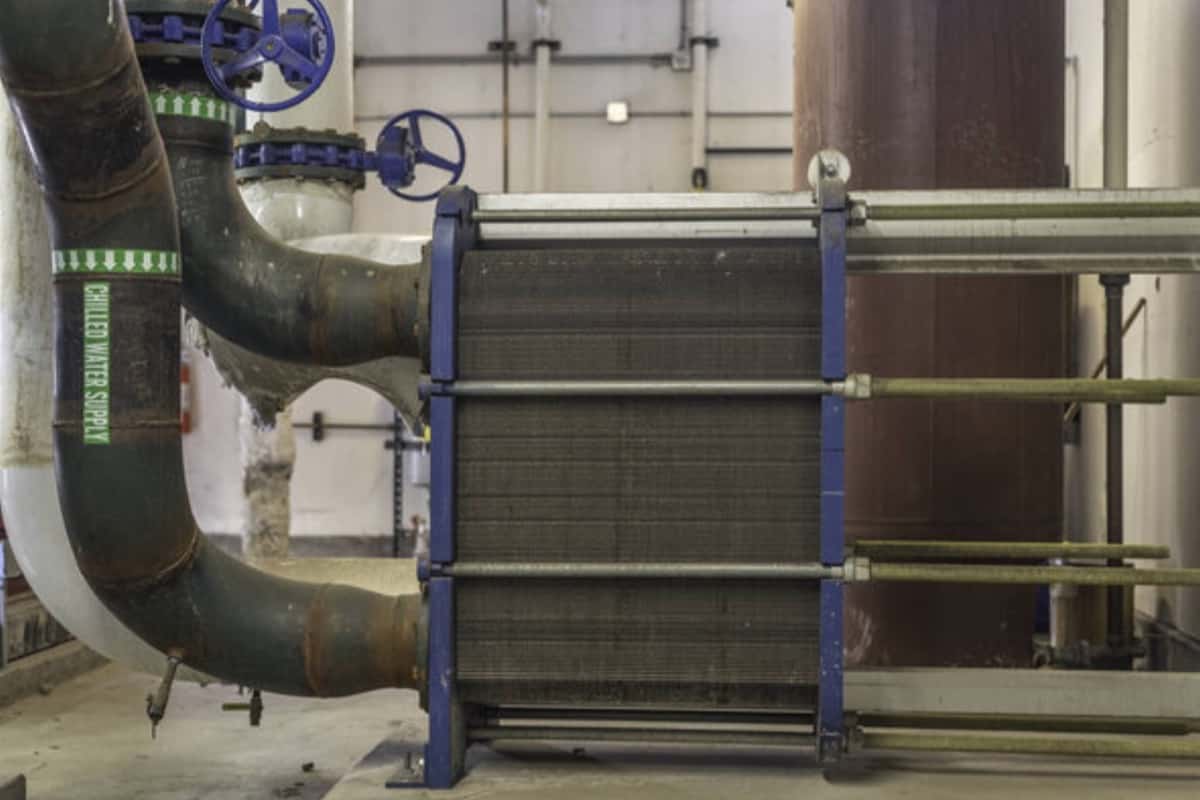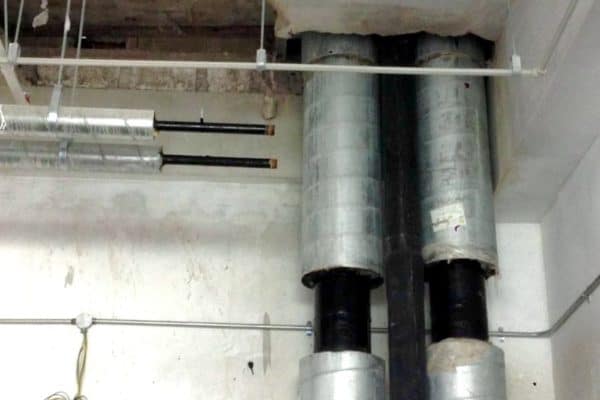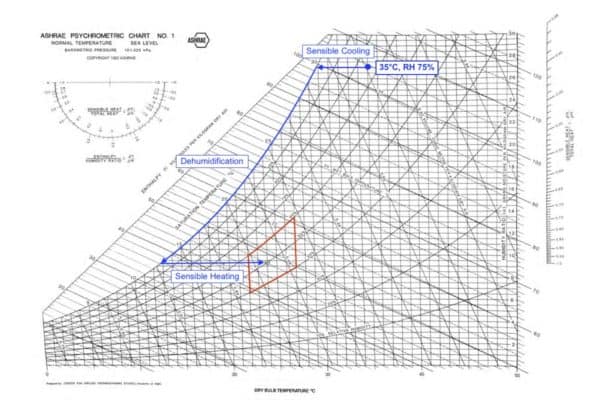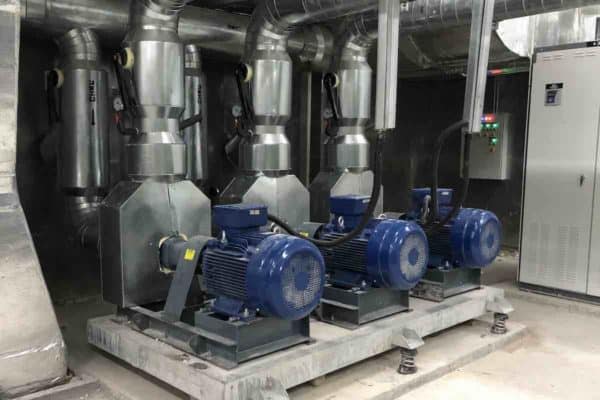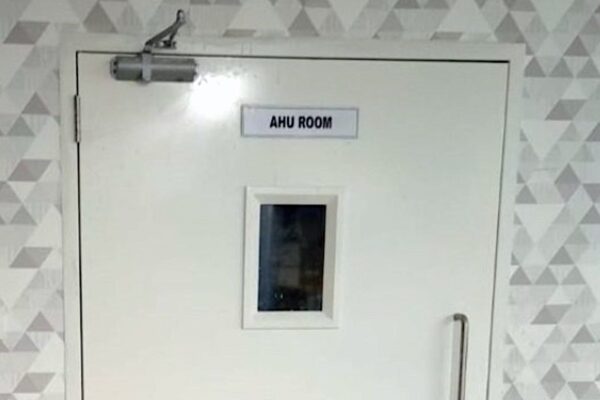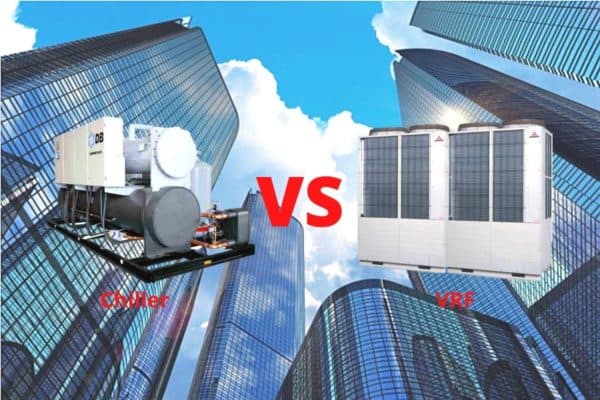5 Types of Heat Exchangers in HVAC (Applications & Highlights)
HVAC units use heat exchangers to transfer heat energy efficiently. Many different types of heat exchangers are developed and constructed over the year. So, what types of heat exchangers are used in HVAC?
Generally, there are 5 types of heat exchangers in HVAC as follow:
- Finned-Tube Heat Exchanger
- Brazed Plate Heat Exchanger
- Shell-and-Tube Heat Exchanger
- Tube-in-Tube Heat Exchanger
- Plate Heat Exchanger
Different types of HVAC units are fitted with different types of heat exchangers. Each heat exchanger has its unique characteristics, applications, advantages as well as disadvantages and problems.
1. Finned-Tube Heat Exchanger
Finned-tube heat exchangers are the most common type of heat exchanger in HVAC. They can be found in both residential and commercial buildings. Finned-tube heat exchangers are used to exchange the heat energy between the air and the refrigerant.
A finned-tube heat exchanger can be found in the following HVAC units:
- Wall-mounted unit
- Ceiling cassette unit
- Ceiling ducted unit
- Floor standing unit
- Ceiling exposed unit
- Window unit
- Through-the-wall unit
- Air handling unit
- Fan coil unit
Finned-tube heat exchangers are mostly found in split air conditioners, multi-split air conditioners, VRF air conditioners, heat pumps and window air conditioners. Centralized HVAC units such as air handling units and fan coil units are also fitted with a finned-tube heat exchanger.

Finned-tube heat exchangers are typically made of aluminium and copper. The fins of the heat exchangers are made of thin alunimium sheets while the tubes of the heat exchangers are made of copper tubes.
In residential buildings, finned-tube heat exchangers are often coated with a layer of anti-corrosion substances. Hence, they have blue color fins. Treated finned-tube heat exchangers are also known as hydrophilic finned-tube heat exchangers.
Residential HVAC units such as the outdoor unit of split air conditioners are mostly exposed to the weather. With blue fins, residential HVAC units last longer. Additionally, they look better with blue fins too.
On the other hand, the finned-tube heat exchangers used in commercial HVAC units such as air handling units and fan coil units are usually not coated with a layer of anti-corrosion substances because they are concealed inside the HVAC units. Such finned-tube heat exchangers are silver in color because of the nature of aluminium.
Finned-tube heat exchangers have many different forms and shapes. The most common shape is sort of like a U-shape which can be seen inside the outdoor unit of split air conditioners. Sometimes, they are arranged in an A-shape which can be seen inside the outdoor unit of air source heat pumps.

Finned-tube heat exchangers are cheap to produce, easy to install and repairable. However, they are bulky. Hence, they are not suitable to be used in compact HVAC units such as water-cooled VRF units.
Because the fins of the heat exchanger are compact, they tend to collect dust over time even though there are filters before them. Nonetheless, they can be cleaned easily with a pressure washer.
The most common problem of HVAC finned-tube heat exchangers is copper tube cracks that lead to refrigerant leakage. But, the cracks can be repaired through brazing. In addition, dented fins are also very common but they can be fixed using a fin comb.
2. Brazed Plate Heat Exchanger
Brazed plate heat exchangers are more commonly used in HVAC units that use water as a medium of heat transfer. They are used to exchange the heat energy between the water and the refrigerant.
A brazed plate heat exchanger can be found in the following HVAC units:
- Air-cooled chiller
- Hybrid chiller
- Air source heat pump
- Water source heat pump
Brazed plate heat exchangers are mostly used in the chilled water system. They can be found inside an air-cooled chiller and a hybrid chiller. Furthermore, they have been used extensively in air source heat pumps and water source heat pumps of the hot water system.

Brazed plate heat exchangers are made of stainless steel and copper. The plates of the heat exchangers are made of thin corrugated stainless steel plates with a thin copper sheet in between.
Most brazed plate heat exchangers are black in color because they are wrapped with a layer of closed-cell insulations to prevent condensation. If the insulations were removed, they have both silver and bronze colors due to stainless steel and copper materials.
The size of HVAC brazed plate heat exchangers is much smaller than finned-tube heat exchangers. Hence, they can be fitted in compact HVAC units. Most of the time, they are rectangular in shape with curved corners.
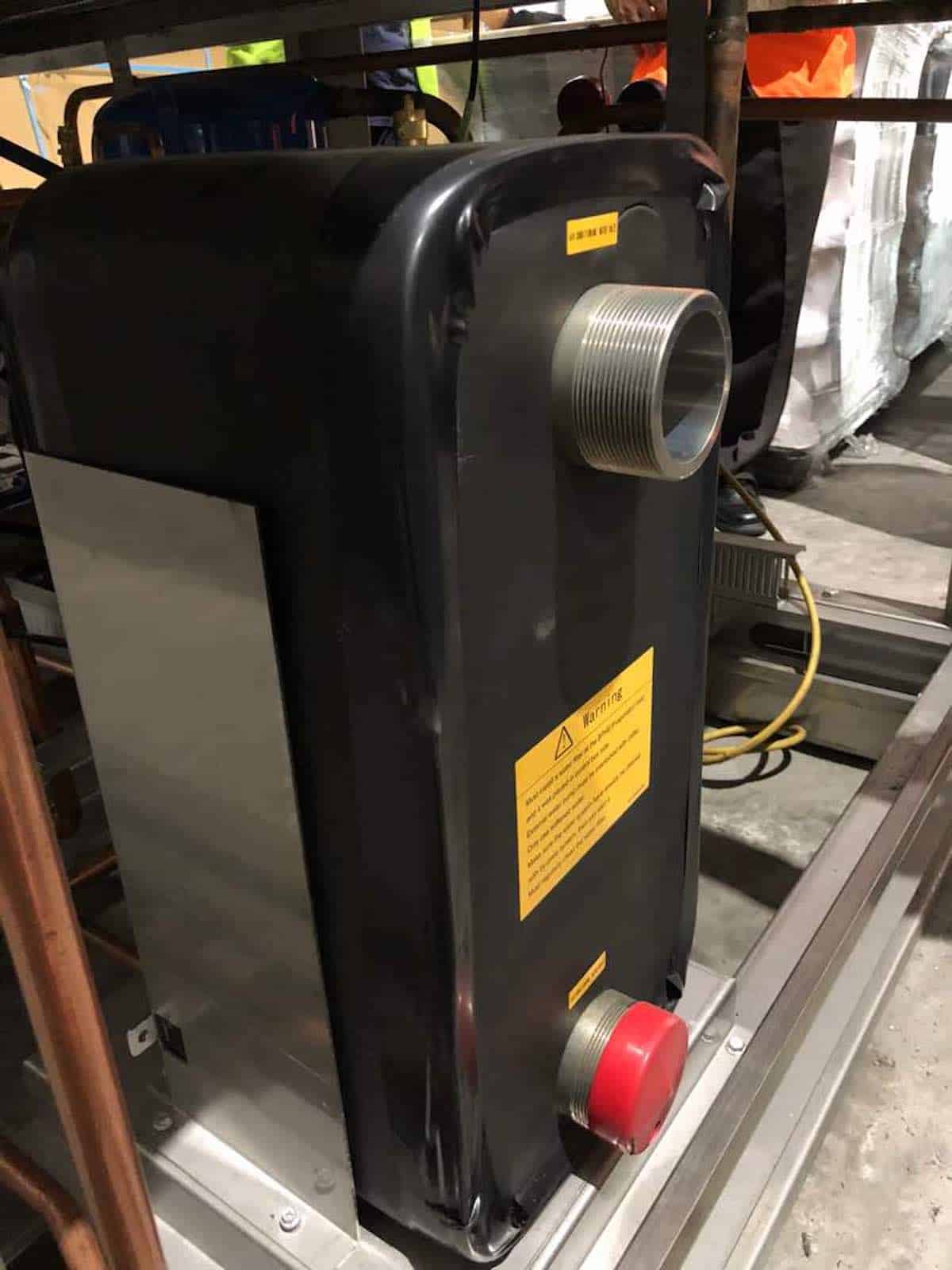
Because the plates of the heat exchanger are packed very tightly together, they are prone to blockages. To prevent frequent blockages, a y-strainer should be installed before the heat exchanger to capture any dirt in the water.
However, the filter mesh of the y-strainer must be finer than the brazed plate heat exchanger. Otherwise, the filtration process is not effective.
Brazed plate heat exchangers are difficult to repair. Most of the time, they are not repairable and replacement is needed. However, if water can’t flow through a brazed plate heat exchanger due to blockages, flushing it with chemicals may fix the problem.
So, service pockets or empty thermowells are recommended in the piping system so that future flushing maintenance work can be carried out without the need to remove the pipe connections.
In addition, cracks may happen inside a brazed plate heat exchanger. Consequently, the flowing water can be contaminated by the refrigerant. For hot water applications, water contamination is harmful. Hence, double wall brazed plate heat exchangers are often preferred for the hot water system.
In the meantime, I would like to inform you that you can learn quicker by getting my HVAC Begin (eBook) if you’re a beginner. But, if you have a year or two of experience, then I would suggest you consider my HVAC Basics (eBook). Nonetheless, I encourage you enroll in my HVAC Beginner Course: 10 Days to Become Competent in HVAC if you want to equipped yourself with a complete set of basic HVAC skills.
HVAC Beginner Course
Learn the most basics and foundational HVAC skills including cooling capacity calculation, equipment selection, duct sizing, pipe sizing, exhaust fan sizing, controls, electrical and more.
3. Shell-and-Tube Heat Exchanger
Shell-and-tube heat exchangers are more common in commercial HVAC units rather than residential HVAC units. A shell-and-tube heat exchanger can be found in the following HVAC units:
- Water-cooled chiller
- Water source heat pump
Shell-and-tube heat exchangers are mostly used in the chilled water system. They are always found on a water-cooled chiller. However, they also can be found on a water source heat pump for hot water.
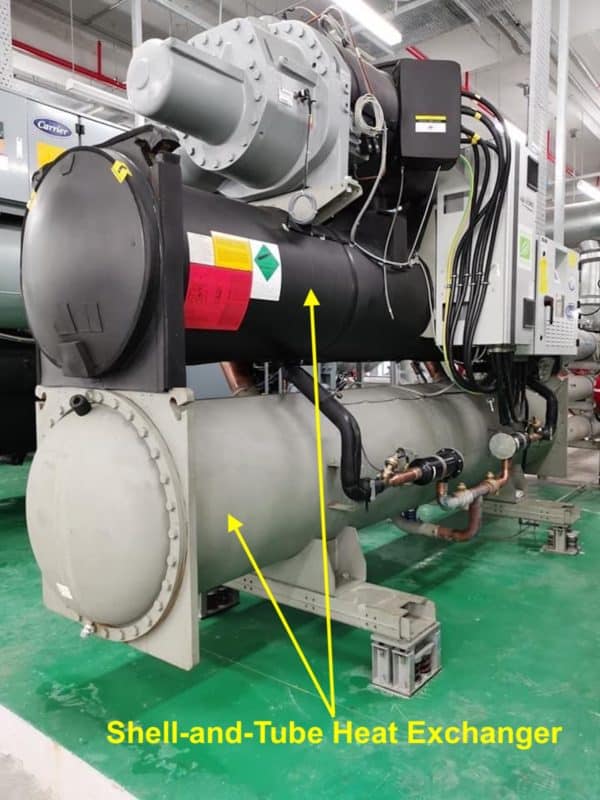
Shell-and-tube heat exchangers are typically made of copper and low-carbon steel. The shell-and-tube heat exchangers in water-cooled chillers can have several different external appearances.
When used as evaporators, the shell-and-tube heat exchangers are black in color because they are wrapped with a layer of closed-cell insulations to prevent condensation.
When used as condensers, the shell-and-tube heat exchangers are usually painted in green color or beige color. However, they can also be painted with other colors depending on the building’s requirements.
Shell-and-tube heat exchangers have two types of flow patterns; a) parallel flow and b) counterflow. Then, the flow can be 1-pass, 2-pass or 3-pass.

Among all, 2-pass counterflow shell-and-tube heat exchangers are more common in HVAC. However, people working in the HVAC industry prefer to call them 2-pass chillers or counterflow chillers.
The number of heat exchanger passes determines the efficiency and the amount of pressure drop across a shell-and-tube heat exchanger. The higher the number of passes, the greater the heat exchange at the expense of a higher pressure drop.
Furthermore, a water-cooled chiller or a shell-and-tube heat exchanger can be categorized as either dry type or flooded type.
In a dry type shell-and-tube heat exchanger, the refrigerant is flowing through the tube while the water is filling up and flowing through the shell. In a flooded type shell-and-tube heat exchanger, the refrigerant is filling up and flowing through the shell while the water is flowing through the tube.
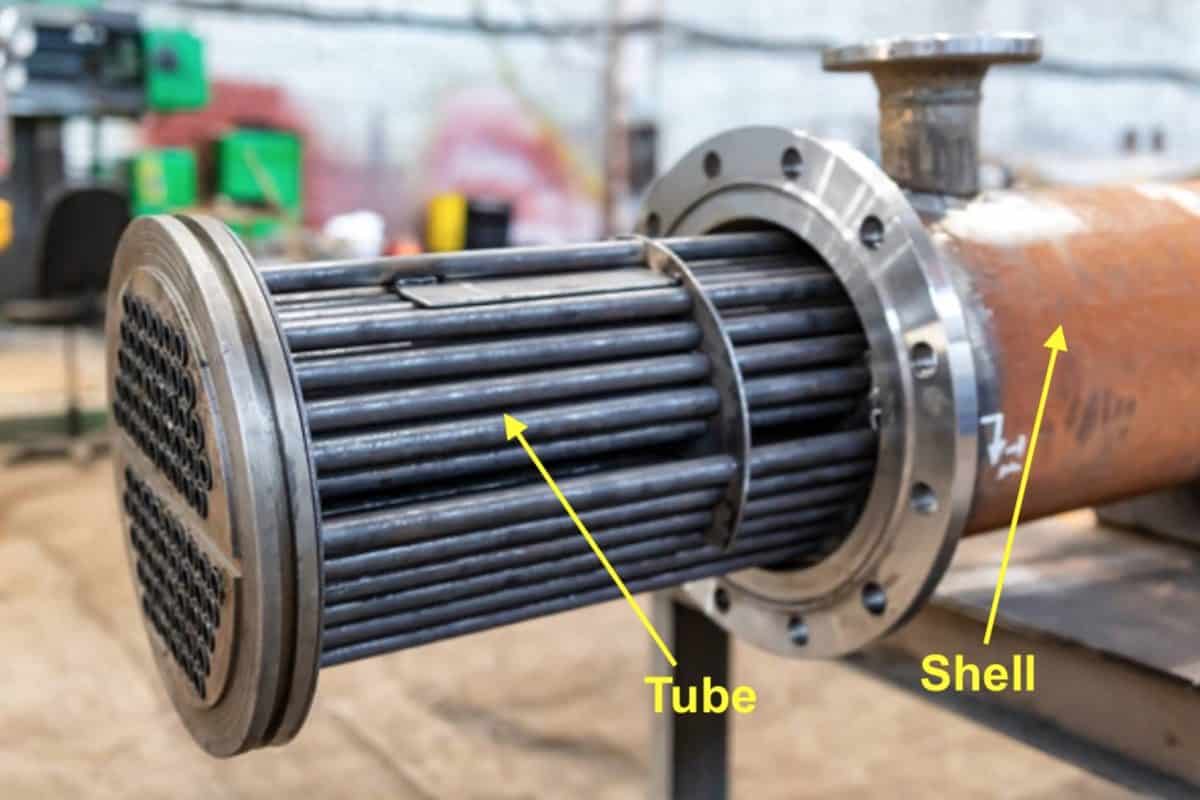
Dry type shell-and-tube heat exchangers are used in low capacity water-cooled chillers while most water-cooled chillers with medium to large capacity use flooded type shell-and-tube heat exchangers.
4. Tube-in-Tube Heat Exchanger
Tube-in-tube heat exchangers are small yet efficient heat exchangers designed for high pressure but low water flow applications. As far as I know, a tube-in-tube heat exchanger can be found in a water-cooled VRF unit.

Tube-in-tube heat exchangers are made of copper and stainless steel. The inner tube is made of corrugated copper tube and the outer tube is made of stainless steel tube with a layer of PVC material and thus, they are black in color.
Sometimes, tube-in-tube heat exchangers are known as coaxial tube heat exchangers.

Water-cooled VRF units are compact and hence, they are often placed above the ceiling or inside a cabinet. They have a compressor to produce cold refrigerant for air conditioning but they need condenser water for heat rejection. Hence, cooling towers and condenser pumps are needed.
The refrigerant of a water-cooled VRF unit is flowing through the outer tube of the heat exchanger while the condenser water is flowing inside the inner corrugated copper tube. Similarly, tube-in-tube heat exchangers can have the refrigerant and the water flow in either parallel flow pattern or counterflow pattern.

Nevertheless, tube-in-tube heat exchangers are rarely seen in HVAC since water-cooled VRF units are also not as common as other types of air conditioners.
5. Plate Heat Exchanger
Plate heat exchangers are fairly common in HVAC but only in large cooling applications. They are more likely to be used in the chilled water system. In HVAC, plate heat exchangers are typically used to exchange the heat energy between two separate sources of chilled water.
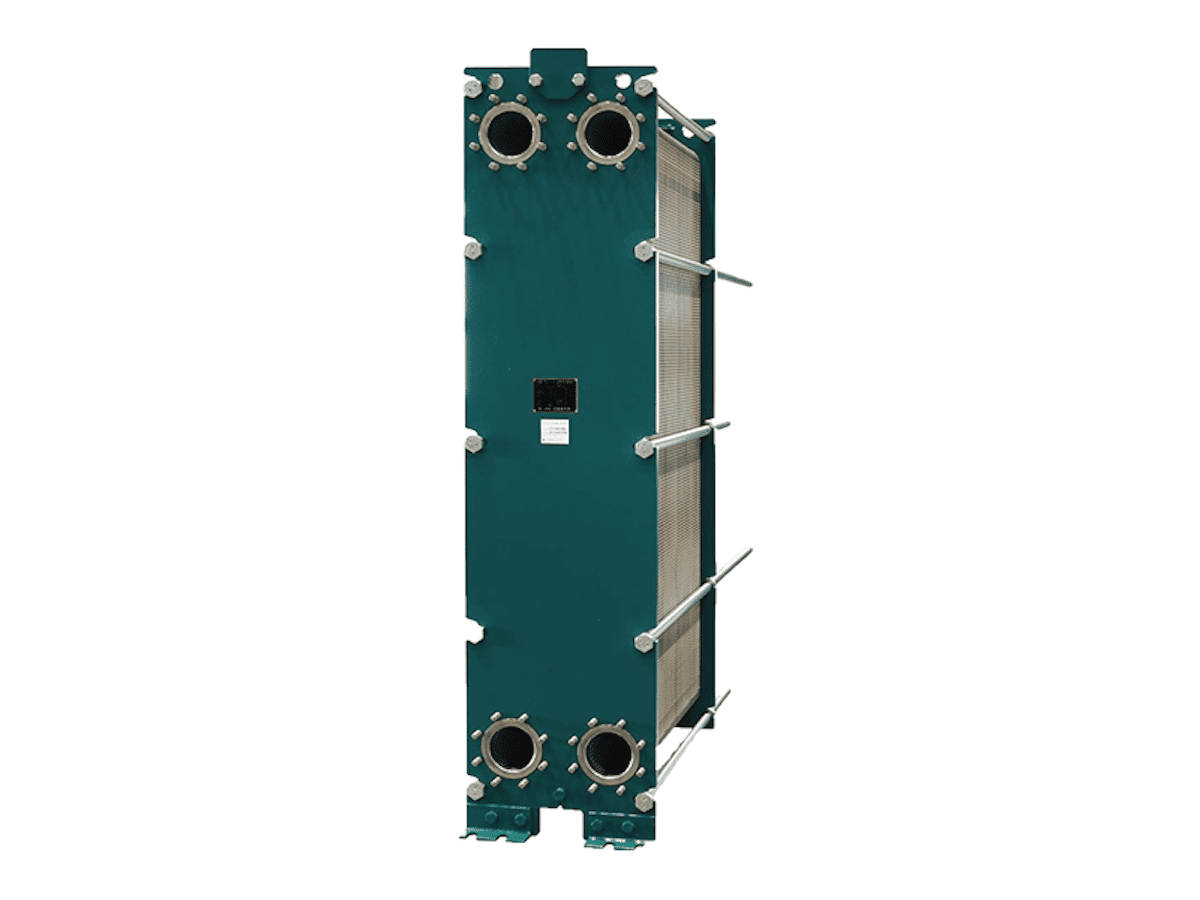
A plate heat exchanger can be found in tall buildings where it is used to break the chilled water system pressure. In addition, a plate heat exchanger can also be found in buildings that use a district cooling system.
Usually, the chilled water system operates at around 10-12 bar of pressure. If the building is very tall and the water pressure exceeds 20 bar, plate heat exchangers can be placed on intermediate floors to break the pressure down to below 20 bar.
When used in the district cooling system, plate heat exchangers can be found in buildings that don’t have chillers. The plate heat exchangers serve as the chillers where they get the chilled water from the district cooling plant.
On one end, the chilled water from the district cooling plant is flowing through the plate heat exchangers. On the other end, the chilled water within the building circulates through the same plate heat exchangers.

Plate heat exchangers used in HVAC are mostly made of thin sheets of stainless steel. Hence, they are silver in color. However, when used for chilled water, they are often black in color because they are wrapped with a layer of closed-cell insulation. But, if panel insulations are used, they can be seen in silver color.
Depending on applications, most HVAC plate heat exchangers are huge. They are often standalone and not incorporated in any HVAC unit. Although plate heat exchangers are very similar to brazed plate heat exchangers, they have additional gaskets and they don’t come in bronze color.
Lastly, consider my HVAC Begin (eBook) if you’re a beginner and you want to have a foundational knowledge in HVAC. But, if you have a year or two of experience, then I would suggest you consider my HVAC Basics (eBook). Nonetheless, I encourage you enroll in my HVAC Beginner Course: 10 Days to Become Competent in HVAC if you want to equipped yourself with a complete set of basic HVAC skills.
HVAC Beginner Course
Learn the most basics and foundational HVAC skills including cooling capacity calculation, equipment selection, duct sizing, pipe sizing, exhaust fan sizing, controls, electrical and more.
If you have anything to add (or ask) about this topic, leave a comment down below!


